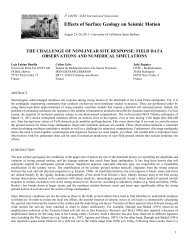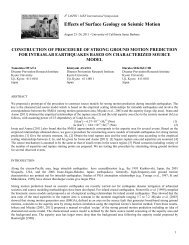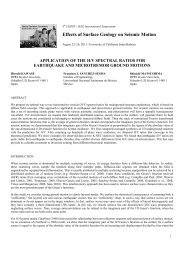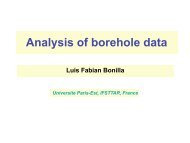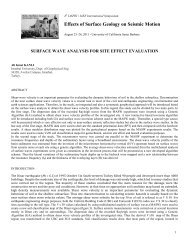a new strategy for developing vs30 maps - ESG4 Conference @ UCSB
a new strategy for developing vs30 maps - ESG4 Conference @ UCSB
a new strategy for developing vs30 maps - ESG4 Conference @ UCSB
You also want an ePaper? Increase the reach of your titles
YUMPU automatically turns print PDFs into web optimized ePapers that Google loves.
From analysis of Fig. 5, we can see the desired contributions of the individual model components: the eastward gradient of Vs 30 from<br />
along west coast of Taiwan in the combined trend model (Fig. 5b), and within a single geologic unit (see Fig. 1c), indicates the slopebased<br />
contribution; the plume-shaped, southernmost NEHRP E-category geologic unit (Fig. 1c; near 120.3E, 22.3N) in the combined<br />
trend model indicates some degree of geologic control; and, the modification of the trend model by the data as seen in Fig. 4d, clearly<br />
indicates the role of individual Vs 30 data on the final model, <strong>for</strong> example, at and around the slowest Vs 30 sites in valleys and along the<br />
west coast, or in the lowering of final Vs 30 values in the mountains in the north-central portion of the island.<br />
The final combined trend model Fig. 5b more closely resembles the original (Fig.1b; Wald and Allen (2007) slope-based model than<br />
the geologic-based model (Fig. 1c), though the slope model overestimated Vs 30 at some northern basin sites. In case of Taiwan, the<br />
slope-model dominance is attributed to the favorable initial agreement of the Wald and Allen model with the observed Vs 30 and the<br />
clear trends of Vs 30 within the separate, homogenous geologic units. It remains to be seen if this slope-model dominance will be the<br />
norm in other tectonic or geomorphic environments. Clearly, however, the final Vs 30 map (Fig. 5d) is an improvement over the Wald<br />
and Allen (2007) slope-based model in that it more closely matches observations at individual Vs 30 sites (Fig. 5a). A profile across<br />
Taiwan (black line in Fig. 5a) is provided in Fig. 7, comparing Vs 30 values along section <strong>for</strong> the trend model (dashed line) and <strong>for</strong> the<br />
final model with the kriged residuals added back in (Fig. 5d).<br />
DISCUSSION<br />
Although the procedure outlined here has only been applied, in this case, to one region, in essence we are proposing a simple “recipe”<br />
<strong>for</strong> <strong>developing</strong> Vs 30 <strong>maps</strong> which should be generally applicable to any region of the world. In the absence of any Vs 30 data, or geologic<br />
<strong>maps</strong>, the default becomes a slope-based Vs 30 map using predetermined Vs 30 –slope correlations determined <strong>for</strong> a comparable tectonic<br />
environment elsewhere. With the addition of sufficient Vs 30 data (say, a few dozen values), the slope-Vs 30 correlation can be refined,<br />
improving on a default trend, regressing <strong>for</strong> only the slope (of topographic slope versus Vs 30 ) and intercept coefficients (equation 2). If<br />
geological <strong>maps</strong> are available, determine if cross-terms are needed, and adjust the use of equation (1) adding cross-terms accordingly.<br />
The complete <strong>strategy</strong> <strong>for</strong> regression-kriging is then per<strong>for</strong>med as described above, shown graphically in the flowchart in Figure 5, is<br />
outlined here:<br />
1) Assemble data sets:<br />
a. Point Vs 30 data and uncertainties (down-hole, SASW, ReMi, CPT, etc.)<br />
b. Assess the quality of the point data, assigning weights to reflect the quality of the measurements if necessary.<br />
c. Digital topography: resolution 30 or 9 arc-second sampling (1 km or 250 m, respectively)<br />
d. Digital geology <strong>maps</strong> (or, potentially, other Vs 30 -proxy <strong>maps</strong>); convert polygons to grids<br />
2) Data preprocessing:<br />
a. Topography:<br />
i. Compute maximum slope values on grid.<br />
ii. Sample slope at Vs 30 observation points.<br />
b. Geology-based Vs 30 assignments:<br />
i. Assign categorical (ordinal) values to geology map units.<br />
ii. Sample geology units at Vs 30 data points.<br />
3) Solve <strong>for</strong> combined slope and geology trend model coefficients. Generate <strong>for</strong>ward model.<br />
4) Compute residuals from the observed Vs 30 values minus the trend model.<br />
5) Analyze Vs 30 residuals (variogram estimation; determine nugget, sill, and range).<br />
6) Krige Vs 30 residuals and generate a grid of kriged residuals.<br />
7) Add gridded kriged Vs 30 residuals back to trend model estimates.<br />
8) Uncertainty analyses: compute cross-validation of data, map uncertainties.<br />
Ongoing improvements in <strong>developing</strong> an optimal <strong>strategy</strong> <strong>for</strong> Vs 30 map development, include: i) the use of higher-resolution<br />
topography (9 rather than 30 arc-second), ii) Employing sufficiency criteria (p-value) <strong>for</strong> employing topographic slope and geology<br />
cross terms (equation 1), and iii) determination of estimated Vs 30 uncertainties. Allen and Wald (2009) and Wills and Gutirrez (2008)<br />
have identified some limitations to higher resolution data, yet we anticipate that switching to 9 arc-second sampling (250-m spacing)<br />
topographic data and re-deriving slope coefficients will be beneficial.<br />
A final consideration is refining the Perl, R, and GMT scripts employed <strong>for</strong> semi-automating the production of Vs 30 <strong>maps</strong> in other<br />
regions. Manual intervention will still be required <strong>for</strong> inspecting the variogram model (autocovariance function) needed <strong>for</strong> kriging<br />
9



